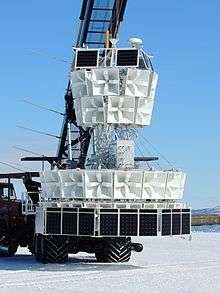Antarctic Impulsive Transient Antenna
The Antarctic Impulsive Transient Antenna (ANITA) experiment has been designed to study ultra-high-energy (UHE) cosmic neutrinos by detecting the radio pulses emitted by their interactions with the Antarctic ice sheet. This is to be accomplished using an array of radio antennas suspended from a helium balloon flying at a height of about 37,000 meters.[1]

The neutrinos, with energies on the order of 1018 eV, produce radio pulses in the ice because of the Askaryan effect. It is thought that these high-energy cosmic neutrinos result from interaction of ultra-high-energy (1020 eV) cosmic rays with the photons of the cosmic microwave background radiation. It is thus hoped that the ANITA experiment can help to explain the origin of these cosmic rays.[2]
Experimental time frame
ANITA-I launched from McMurdo, Antarctica in the summer of 2006–07. The array should travel around the continent with the circumpolar winds for approximately a month before being recovered by the CSBF. Each successive mission (if funded) would be at two-year intervals. ANITA-II, a modified instrument with 40 antennas, launched from McMurdo Station in the summer of 2008–2009. ANITA-III, expected to improve sensitivity by a factor of 5–10, launched in December 2014.
ANITA-IV launched in December 2016,[3] with a lighter overall build, tunable notch filters and an improved trigger system.
Funding
ANITA is a collaboration of multiple universities, led by UH Manoa[4] and funded through grants by NASA and the U.S. Department of Energy.[5]
Results
As of January 2020, ANITA has made three flights and detected numerous neutrinos coming from above the experiment, where the radio waves are reflected before they reach ANITA. Two events have signatures indicating that they came from below. These events were unexpected as Earth should absorb most neutrinos of this energy.[6][7] A follow-up study by the IceCube experiment, which is more sensitive than ANITA and located deep within the ice, did not detect any neutrinos from the direction of the apparent source from below.[8] It is therefore thought that the observed events come from cosmic rays that have reflected off the ice but for unexplained reason did not change polarization when reflected.[9]
Collaborators
The current ANITA collaboration team includes members from the University of Hawaii at Manoa; University of California, Los Angeles; The Ohio State University; The University of Delaware; The University of Kansas; Washington University; the NASA Jet Propulsion Laboratory; University College London; University of Chicago; National Taiwan University; and the California Polytechnic State University.
See also
- IceCube Neutrino Observatory
- Radio Ice Cerenkov Experiment
- Neutrino telescope
- Encounters at the End of the World
References
- "ANITA: Antarctic Impulsive Transient Antenna".
- "High flyer listens for cosmic pings". New Scientist. 23 December 2006.
- "CSBF: Payload monitoring ANITA-IV". Archived from the original on 2016-12-02. Retrieved 2016-12-02.
- "ANITA III launched over Antarctica | The Source | Washington University in St. Louis". The Source. 2014-12-23. Retrieved 2020-01-15.
- "Collaboration | ANITA". Retrieved 2020-01-15.
- Cho, Adrian (2018-09-27). "Oddball particles tunneling through Earth could point to new physics". Science. doi:10.1126/science.aav5588.
- Gorham, P. W.; Rotter, B.; Allison, P.; Banerjee, O.; Batten, L.; Beatty, J. J.; Bechtol, K.; Belov, K.; Besson, D. Z.; Binns, W. R.; Bugaev, V.; Cao, P.; Chen, C. C.; Chen, C. H.; Chen, P.; Clem, J. M.; Connolly, A.; Cremonesi, L.; Dailey, B.; Deaconu, C.; Dowkontt, P. F.; Fox, B. D.; Gordon, J. W. H.; Hast, C.; Hill, B.; Hughes, K.; Huang, J. J.; Hupe, R.; Israel, M. H.; et al. (2018). "Observation of an Unusual Upward-Going Cosmic-Ray-like Event in the Third Flight of ANITA". Physical Review Letters. 121 (16): 161102. arXiv:1803.05088. Bibcode:2018PhRvL.121p1102G. doi:10.1103/PhysRevLett.121.161102. PMID 30387639.
- "IceCube rules out last Standard Model explanation of ANITA's anomalous neutrino events". January 8, 2020.
- Strickland, Ashley (May 27, 2020). "Scientists didn't detect a parallel universe in Antarctica. But they are learning more about mysterious, ghostly neutrinos". CNN.
External links
- Miocinovic, P.; et al. (2005). "Tuning into UHE Neutrinos in Antarctica – the ANITA Experiment". Econf C. 041213: 2516. arXiv:astro-ph/0503304. Bibcode:2005tsra.conf..765M.
- University of California article
- University of Hawaii article